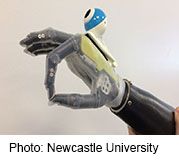
An artificial hand that “sees” is being tested for the first time.
The “bionic hand” allows the wearer to reach for objects automatically, without thinking, just as a real hand would, British researchers report.
The hand has a camera that instantaneously takes a picture of an object in front of it, to determine the shape and size of the object. Muscles in the arm are then stimulated to prompt the artificial hand to grasp the object.
The study authors said that the hand is being tested in a small number of amputee patients.
“Prosthetic limbs have changed very little in the past 100 years — the design is much better and the materials are lighter weight and more durable, but they still work in the same way,” said study co-author Kianoush Nazarpour. He is a senior lecturer in biomedical engineering at Newcastle University in England.
“Using computer vision, we have developed a bionic hand which can respond automatically. In fact, just like a real hand, the user can reach out and pick up a cup or a biscuit with nothing more than a quick glance in the right direction,” Nazarpour explained in a university news release.
“Responsiveness has been one of the main barriers to artificial limbs. For many amputees, the reference point is their healthy arm or leg, so prosthetics seem slow and cumbersome in comparison. Now, for the first time in a century, we have developed an ‘intuitive’ hand that can react without thinking,” Nazarpour said.
The work is part of a larger effort to design a bionic hand that can sense pressure and temperature, and send that information back to the brain, the researchers noted.
Much like Luke Skywalker’s artificial hand, the electrodes in the bionic limb would wrap around the nerve endings in the arm, the scientists explained. This would mean the brain could communicate directly with the artificial hand.
“It’s a stepping stone towards our ultimate goal,” Nazarpour said of the “seeing” hand. “But importantly, it’s cheap and it can be implemented soon because it doesn’t require new prosthetics — we can just adapt the ones we have.”
In the United States, 500,000 people lose all or part of their upper limbs each year, the study authors noted.
The research was published online May 3 in the Journal of Neural Engineering.
More information
The Amputation Coalition has more on prosthetics.
Source: HealthDay

Leave a Reply